MGMT20135: Reviewing Language's Effect on Critical Thinking
VerifiedAdded on 2023/06/09
|7
|2431
|159
Report
AI Summary
This report provides a critical analysis of the article "How might language affect critical thinking performance?" by Manalo and Sheppard (2016). The article explores the relationship between language proficiency and the ability to demonstrate critical thinking skills, particularly among students from diverse linguistic backgrounds. The review evaluates the research methodology, findings, and limitations of the study, highlighting the connection between linguistic proficiency and critical thought processes. It also discusses the implications of the research for classroom guidance and future studies, suggesting further investigation into the experiences of bilingual students with fluency in multiple languages. Desklib is a great platform to find solved assignments and past papers.
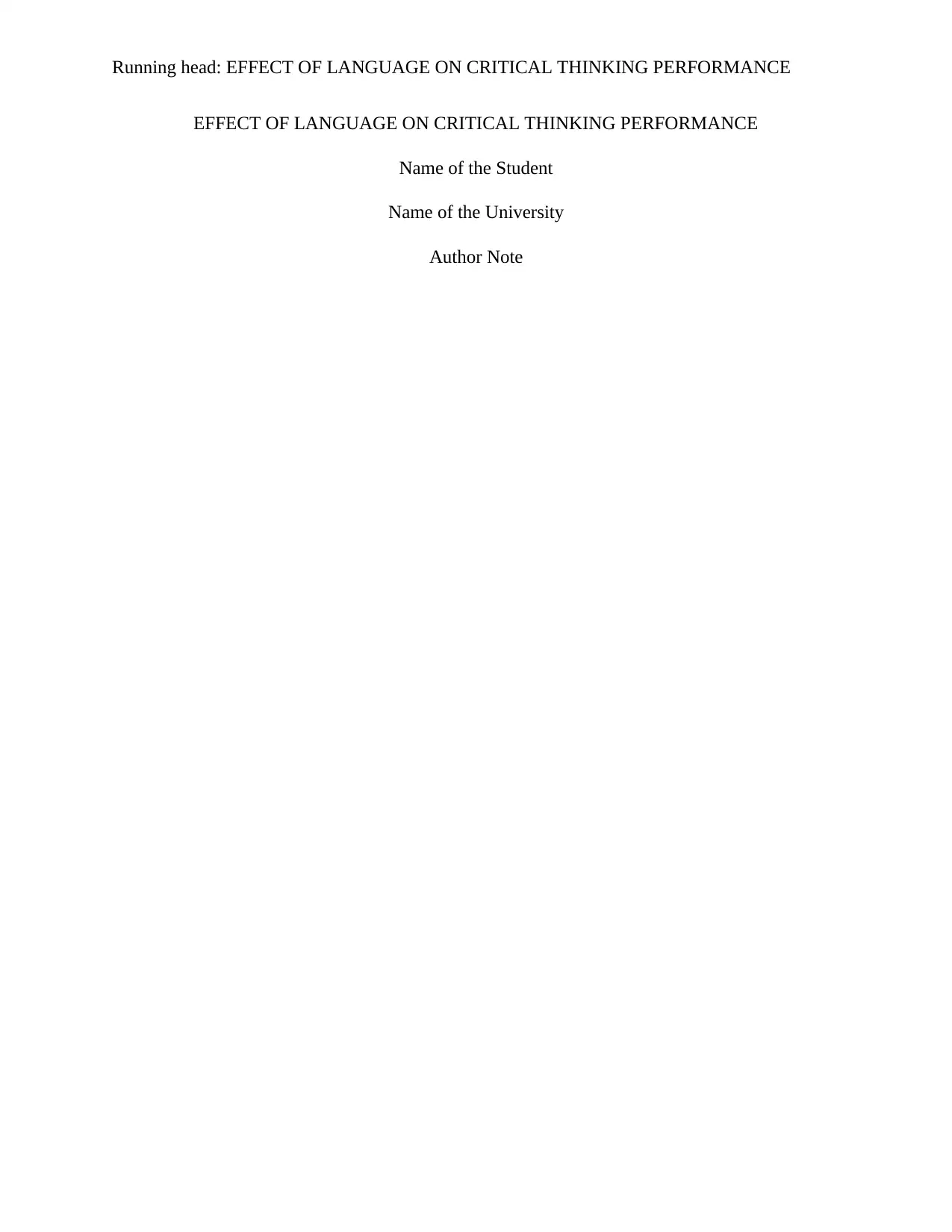
Running head: EFFECT OF LANGUAGE ON CRITICAL THINKING PERFORMANCE
EFFECT OF LANGUAGE ON CRITICAL THINKING PERFORMANCE
Name of the Student
Name of the University
Author Note
EFFECT OF LANGUAGE ON CRITICAL THINKING PERFORMANCE
Name of the Student
Name of the University
Author Note
Paraphrase This Document
Need a fresh take? Get an instant paraphrase of this document with our AI Paraphraser
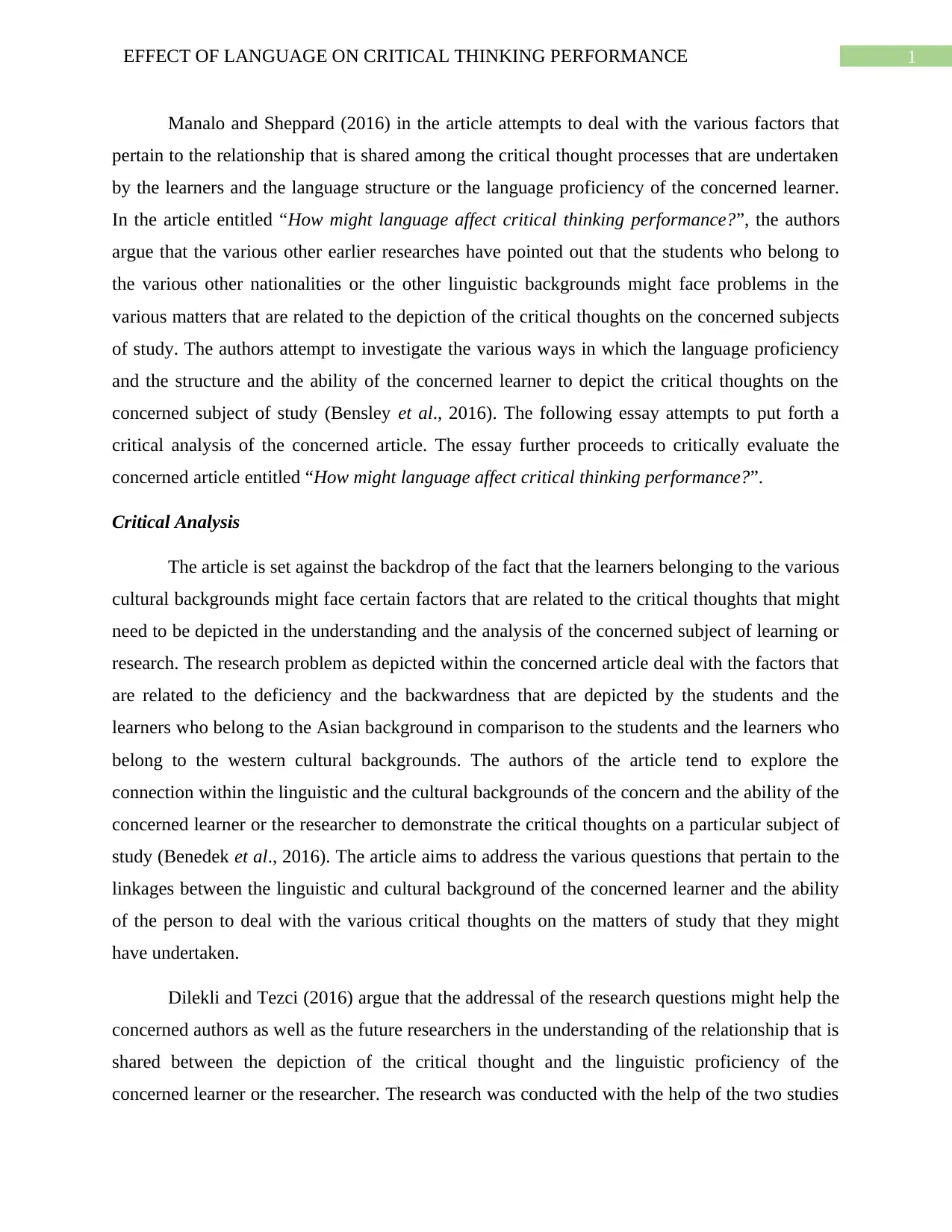
1EFFECT OF LANGUAGE ON CRITICAL THINKING PERFORMANCE
Manalo and Sheppard (2016) in the article attempts to deal with the various factors that
pertain to the relationship that is shared among the critical thought processes that are undertaken
by the learners and the language structure or the language proficiency of the concerned learner.
In the article entitled “How might language affect critical thinking performance?”, the authors
argue that the various other earlier researches have pointed out that the students who belong to
the various other nationalities or the other linguistic backgrounds might face problems in the
various matters that are related to the depiction of the critical thoughts on the concerned subjects
of study. The authors attempt to investigate the various ways in which the language proficiency
and the structure and the ability of the concerned learner to depict the critical thoughts on the
concerned subject of study (Bensley et al., 2016). The following essay attempts to put forth a
critical analysis of the concerned article. The essay further proceeds to critically evaluate the
concerned article entitled “How might language affect critical thinking performance?”.
Critical Analysis
The article is set against the backdrop of the fact that the learners belonging to the various
cultural backgrounds might face certain factors that are related to the critical thoughts that might
need to be depicted in the understanding and the analysis of the concerned subject of learning or
research. The research problem as depicted within the concerned article deal with the factors that
are related to the deficiency and the backwardness that are depicted by the students and the
learners who belong to the Asian background in comparison to the students and the learners who
belong to the western cultural backgrounds. The authors of the article tend to explore the
connection within the linguistic and the cultural backgrounds of the concern and the ability of the
concerned learner or the researcher to demonstrate the critical thoughts on a particular subject of
study (Benedek et al., 2016). The article aims to address the various questions that pertain to the
linkages between the linguistic and cultural background of the concerned learner and the ability
of the person to deal with the various critical thoughts on the matters of study that they might
have undertaken.
Dilekli and Tezci (2016) argue that the addressal of the research questions might help the
concerned authors as well as the future researchers in the understanding of the relationship that is
shared between the depiction of the critical thought and the linguistic proficiency of the
concerned learner or the researcher. The research was conducted with the help of the two studies
Manalo and Sheppard (2016) in the article attempts to deal with the various factors that
pertain to the relationship that is shared among the critical thought processes that are undertaken
by the learners and the language structure or the language proficiency of the concerned learner.
In the article entitled “How might language affect critical thinking performance?”, the authors
argue that the various other earlier researches have pointed out that the students who belong to
the various other nationalities or the other linguistic backgrounds might face problems in the
various matters that are related to the depiction of the critical thoughts on the concerned subjects
of study. The authors attempt to investigate the various ways in which the language proficiency
and the structure and the ability of the concerned learner to depict the critical thoughts on the
concerned subject of study (Bensley et al., 2016). The following essay attempts to put forth a
critical analysis of the concerned article. The essay further proceeds to critically evaluate the
concerned article entitled “How might language affect critical thinking performance?”.
Critical Analysis
The article is set against the backdrop of the fact that the learners belonging to the various
cultural backgrounds might face certain factors that are related to the critical thoughts that might
need to be depicted in the understanding and the analysis of the concerned subject of learning or
research. The research problem as depicted within the concerned article deal with the factors that
are related to the deficiency and the backwardness that are depicted by the students and the
learners who belong to the Asian background in comparison to the students and the learners who
belong to the western cultural backgrounds. The authors of the article tend to explore the
connection within the linguistic and the cultural backgrounds of the concern and the ability of the
concerned learner or the researcher to demonstrate the critical thoughts on a particular subject of
study (Benedek et al., 2016). The article aims to address the various questions that pertain to the
linkages between the linguistic and cultural background of the concerned learner and the ability
of the person to deal with the various critical thoughts on the matters of study that they might
have undertaken.
Dilekli and Tezci (2016) argue that the addressal of the research questions might help the
concerned authors as well as the future researchers in the understanding of the relationship that is
shared between the depiction of the critical thought and the linguistic proficiency of the
concerned learner or the researcher. The research was conducted with the help of the two studies
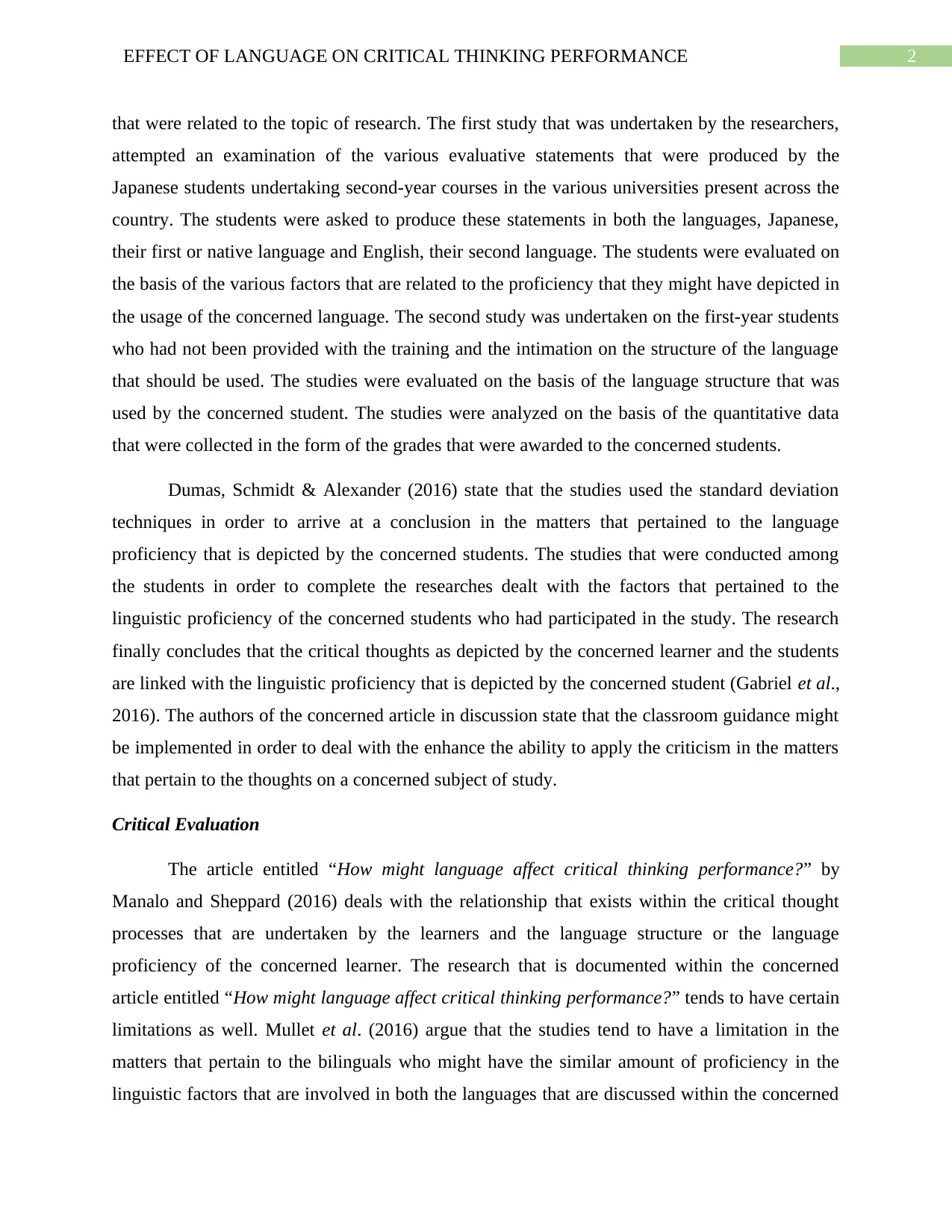
2EFFECT OF LANGUAGE ON CRITICAL THINKING PERFORMANCE
that were related to the topic of research. The first study that was undertaken by the researchers,
attempted an examination of the various evaluative statements that were produced by the
Japanese students undertaking second-year courses in the various universities present across the
country. The students were asked to produce these statements in both the languages, Japanese,
their first or native language and English, their second language. The students were evaluated on
the basis of the various factors that are related to the proficiency that they might have depicted in
the usage of the concerned language. The second study was undertaken on the first-year students
who had not been provided with the training and the intimation on the structure of the language
that should be used. The studies were evaluated on the basis of the language structure that was
used by the concerned student. The studies were analyzed on the basis of the quantitative data
that were collected in the form of the grades that were awarded to the concerned students.
Dumas, Schmidt & Alexander (2016) state that the studies used the standard deviation
techniques in order to arrive at a conclusion in the matters that pertained to the language
proficiency that is depicted by the concerned students. The studies that were conducted among
the students in order to complete the researches dealt with the factors that pertained to the
linguistic proficiency of the concerned students who had participated in the study. The research
finally concludes that the critical thoughts as depicted by the concerned learner and the students
are linked with the linguistic proficiency that is depicted by the concerned student (Gabriel et al.,
2016). The authors of the concerned article in discussion state that the classroom guidance might
be implemented in order to deal with the enhance the ability to apply the criticism in the matters
that pertain to the thoughts on a concerned subject of study.
Critical Evaluation
The article entitled “How might language affect critical thinking performance?” by
Manalo and Sheppard (2016) deals with the relationship that exists within the critical thought
processes that are undertaken by the learners and the language structure or the language
proficiency of the concerned learner. The research that is documented within the concerned
article entitled “How might language affect critical thinking performance?” tends to have certain
limitations as well. Mullet et al. (2016) argue that the studies tend to have a limitation in the
matters that pertain to the bilinguals who might have the similar amount of proficiency in the
linguistic factors that are involved in both the languages that are discussed within the concerned
that were related to the topic of research. The first study that was undertaken by the researchers,
attempted an examination of the various evaluative statements that were produced by the
Japanese students undertaking second-year courses in the various universities present across the
country. The students were asked to produce these statements in both the languages, Japanese,
their first or native language and English, their second language. The students were evaluated on
the basis of the various factors that are related to the proficiency that they might have depicted in
the usage of the concerned language. The second study was undertaken on the first-year students
who had not been provided with the training and the intimation on the structure of the language
that should be used. The studies were evaluated on the basis of the language structure that was
used by the concerned student. The studies were analyzed on the basis of the quantitative data
that were collected in the form of the grades that were awarded to the concerned students.
Dumas, Schmidt & Alexander (2016) state that the studies used the standard deviation
techniques in order to arrive at a conclusion in the matters that pertained to the language
proficiency that is depicted by the concerned students. The studies that were conducted among
the students in order to complete the researches dealt with the factors that pertained to the
linguistic proficiency of the concerned students who had participated in the study. The research
finally concludes that the critical thoughts as depicted by the concerned learner and the students
are linked with the linguistic proficiency that is depicted by the concerned student (Gabriel et al.,
2016). The authors of the concerned article in discussion state that the classroom guidance might
be implemented in order to deal with the enhance the ability to apply the criticism in the matters
that pertain to the thoughts on a concerned subject of study.
Critical Evaluation
The article entitled “How might language affect critical thinking performance?” by
Manalo and Sheppard (2016) deals with the relationship that exists within the critical thought
processes that are undertaken by the learners and the language structure or the language
proficiency of the concerned learner. The research that is documented within the concerned
article entitled “How might language affect critical thinking performance?” tends to have certain
limitations as well. Mullet et al. (2016) argue that the studies tend to have a limitation in the
matters that pertain to the bilinguals who might have the similar amount of proficiency in the
linguistic factors that are involved in both the languages that are discussed within the concerned
⊘ This is a preview!⊘
Do you want full access?
Subscribe today to unlock all pages.

Trusted by 1+ million students worldwide
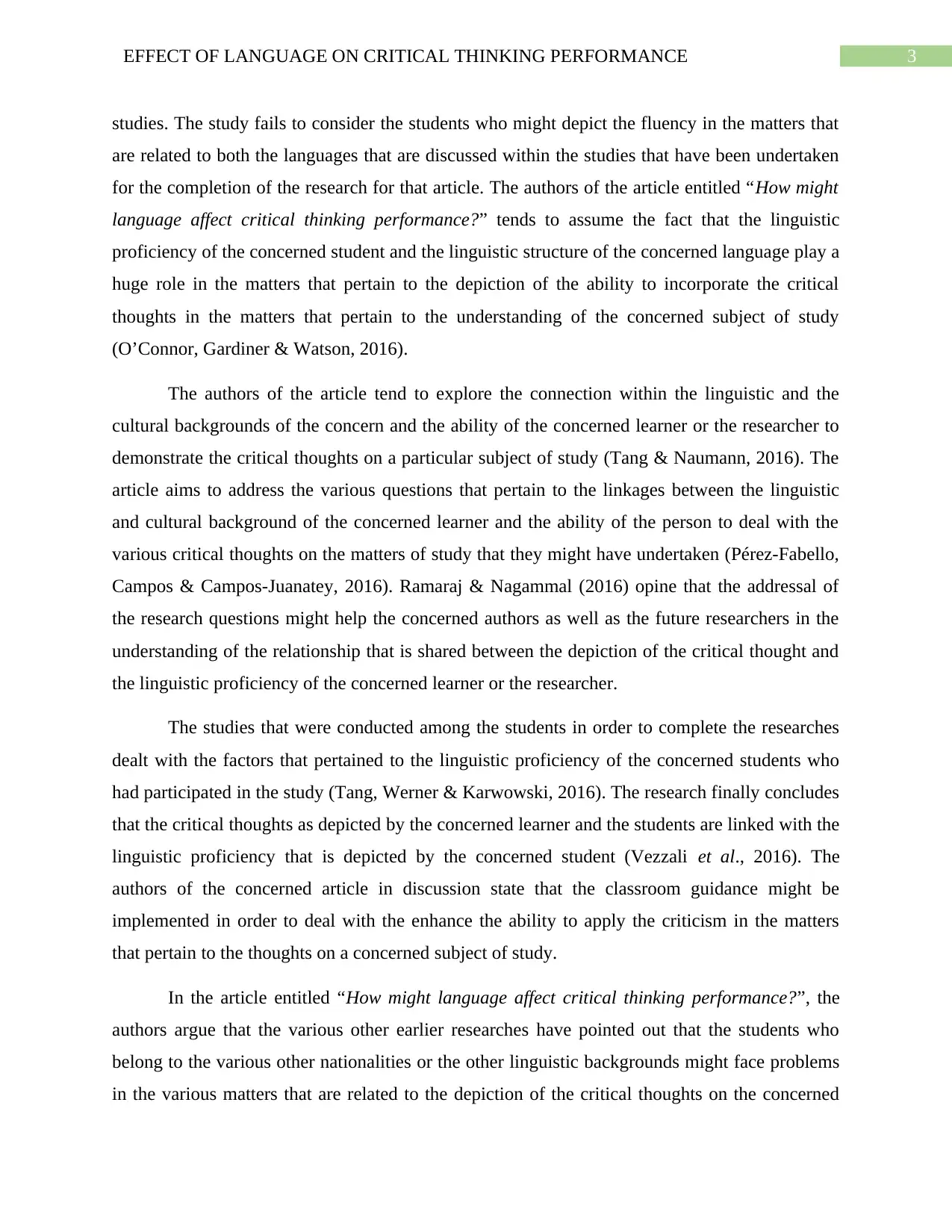
3EFFECT OF LANGUAGE ON CRITICAL THINKING PERFORMANCE
studies. The study fails to consider the students who might depict the fluency in the matters that
are related to both the languages that are discussed within the studies that have been undertaken
for the completion of the research for that article. The authors of the article entitled “How might
language affect critical thinking performance?” tends to assume the fact that the linguistic
proficiency of the concerned student and the linguistic structure of the concerned language play a
huge role in the matters that pertain to the depiction of the ability to incorporate the critical
thoughts in the matters that pertain to the understanding of the concerned subject of study
(O’Connor, Gardiner & Watson, 2016).
The authors of the article tend to explore the connection within the linguistic and the
cultural backgrounds of the concern and the ability of the concerned learner or the researcher to
demonstrate the critical thoughts on a particular subject of study (Tang & Naumann, 2016). The
article aims to address the various questions that pertain to the linkages between the linguistic
and cultural background of the concerned learner and the ability of the person to deal with the
various critical thoughts on the matters of study that they might have undertaken (Pérez-Fabello,
Campos & Campos-Juanatey, 2016). Ramaraj & Nagammal (2016) opine that the addressal of
the research questions might help the concerned authors as well as the future researchers in the
understanding of the relationship that is shared between the depiction of the critical thought and
the linguistic proficiency of the concerned learner or the researcher.
The studies that were conducted among the students in order to complete the researches
dealt with the factors that pertained to the linguistic proficiency of the concerned students who
had participated in the study (Tang, Werner & Karwowski, 2016). The research finally concludes
that the critical thoughts as depicted by the concerned learner and the students are linked with the
linguistic proficiency that is depicted by the concerned student (Vezzali et al., 2016). The
authors of the concerned article in discussion state that the classroom guidance might be
implemented in order to deal with the enhance the ability to apply the criticism in the matters
that pertain to the thoughts on a concerned subject of study.
In the article entitled “How might language affect critical thinking performance?”, the
authors argue that the various other earlier researches have pointed out that the students who
belong to the various other nationalities or the other linguistic backgrounds might face problems
in the various matters that are related to the depiction of the critical thoughts on the concerned
studies. The study fails to consider the students who might depict the fluency in the matters that
are related to both the languages that are discussed within the studies that have been undertaken
for the completion of the research for that article. The authors of the article entitled “How might
language affect critical thinking performance?” tends to assume the fact that the linguistic
proficiency of the concerned student and the linguistic structure of the concerned language play a
huge role in the matters that pertain to the depiction of the ability to incorporate the critical
thoughts in the matters that pertain to the understanding of the concerned subject of study
(O’Connor, Gardiner & Watson, 2016).
The authors of the article tend to explore the connection within the linguistic and the
cultural backgrounds of the concern and the ability of the concerned learner or the researcher to
demonstrate the critical thoughts on a particular subject of study (Tang & Naumann, 2016). The
article aims to address the various questions that pertain to the linkages between the linguistic
and cultural background of the concerned learner and the ability of the person to deal with the
various critical thoughts on the matters of study that they might have undertaken (Pérez-Fabello,
Campos & Campos-Juanatey, 2016). Ramaraj & Nagammal (2016) opine that the addressal of
the research questions might help the concerned authors as well as the future researchers in the
understanding of the relationship that is shared between the depiction of the critical thought and
the linguistic proficiency of the concerned learner or the researcher.
The studies that were conducted among the students in order to complete the researches
dealt with the factors that pertained to the linguistic proficiency of the concerned students who
had participated in the study (Tang, Werner & Karwowski, 2016). The research finally concludes
that the critical thoughts as depicted by the concerned learner and the students are linked with the
linguistic proficiency that is depicted by the concerned student (Vezzali et al., 2016). The
authors of the concerned article in discussion state that the classroom guidance might be
implemented in order to deal with the enhance the ability to apply the criticism in the matters
that pertain to the thoughts on a concerned subject of study.
In the article entitled “How might language affect critical thinking performance?”, the
authors argue that the various other earlier researches have pointed out that the students who
belong to the various other nationalities or the other linguistic backgrounds might face problems
in the various matters that are related to the depiction of the critical thoughts on the concerned
Paraphrase This Document
Need a fresh take? Get an instant paraphrase of this document with our AI Paraphraser
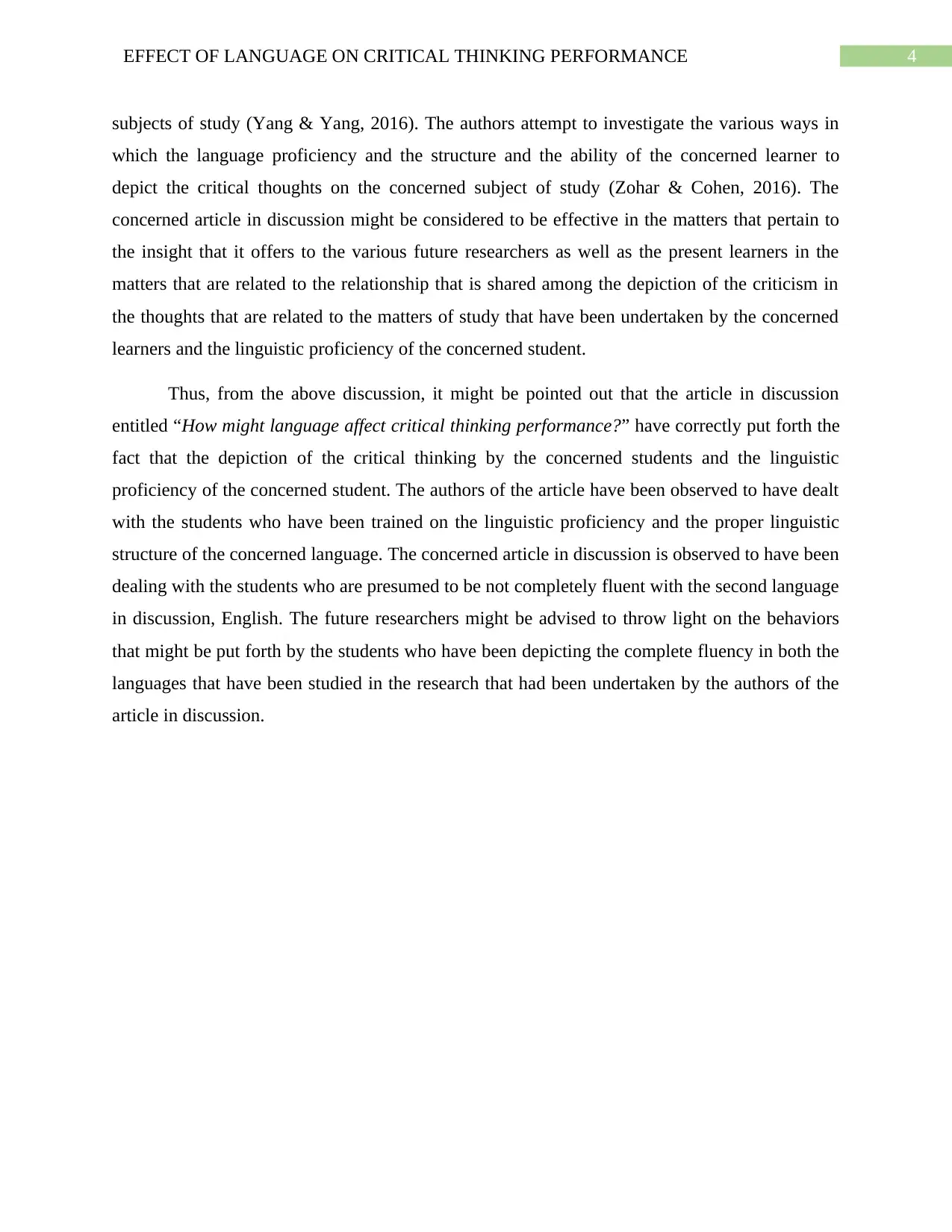
4EFFECT OF LANGUAGE ON CRITICAL THINKING PERFORMANCE
subjects of study (Yang & Yang, 2016). The authors attempt to investigate the various ways in
which the language proficiency and the structure and the ability of the concerned learner to
depict the critical thoughts on the concerned subject of study (Zohar & Cohen, 2016). The
concerned article in discussion might be considered to be effective in the matters that pertain to
the insight that it offers to the various future researchers as well as the present learners in the
matters that are related to the relationship that is shared among the depiction of the criticism in
the thoughts that are related to the matters of study that have been undertaken by the concerned
learners and the linguistic proficiency of the concerned student.
Thus, from the above discussion, it might be pointed out that the article in discussion
entitled “How might language affect critical thinking performance?” have correctly put forth the
fact that the depiction of the critical thinking by the concerned students and the linguistic
proficiency of the concerned student. The authors of the article have been observed to have dealt
with the students who have been trained on the linguistic proficiency and the proper linguistic
structure of the concerned language. The concerned article in discussion is observed to have been
dealing with the students who are presumed to be not completely fluent with the second language
in discussion, English. The future researchers might be advised to throw light on the behaviors
that might be put forth by the students who have been depicting the complete fluency in both the
languages that have been studied in the research that had been undertaken by the authors of the
article in discussion.
subjects of study (Yang & Yang, 2016). The authors attempt to investigate the various ways in
which the language proficiency and the structure and the ability of the concerned learner to
depict the critical thoughts on the concerned subject of study (Zohar & Cohen, 2016). The
concerned article in discussion might be considered to be effective in the matters that pertain to
the insight that it offers to the various future researchers as well as the present learners in the
matters that are related to the relationship that is shared among the depiction of the criticism in
the thoughts that are related to the matters of study that have been undertaken by the concerned
learners and the linguistic proficiency of the concerned student.
Thus, from the above discussion, it might be pointed out that the article in discussion
entitled “How might language affect critical thinking performance?” have correctly put forth the
fact that the depiction of the critical thinking by the concerned students and the linguistic
proficiency of the concerned student. The authors of the article have been observed to have dealt
with the students who have been trained on the linguistic proficiency and the proper linguistic
structure of the concerned language. The concerned article in discussion is observed to have been
dealing with the students who are presumed to be not completely fluent with the second language
in discussion, English. The future researchers might be advised to throw light on the behaviors
that might be put forth by the students who have been depicting the complete fluency in both the
languages that have been studied in the research that had been undertaken by the authors of the
article in discussion.
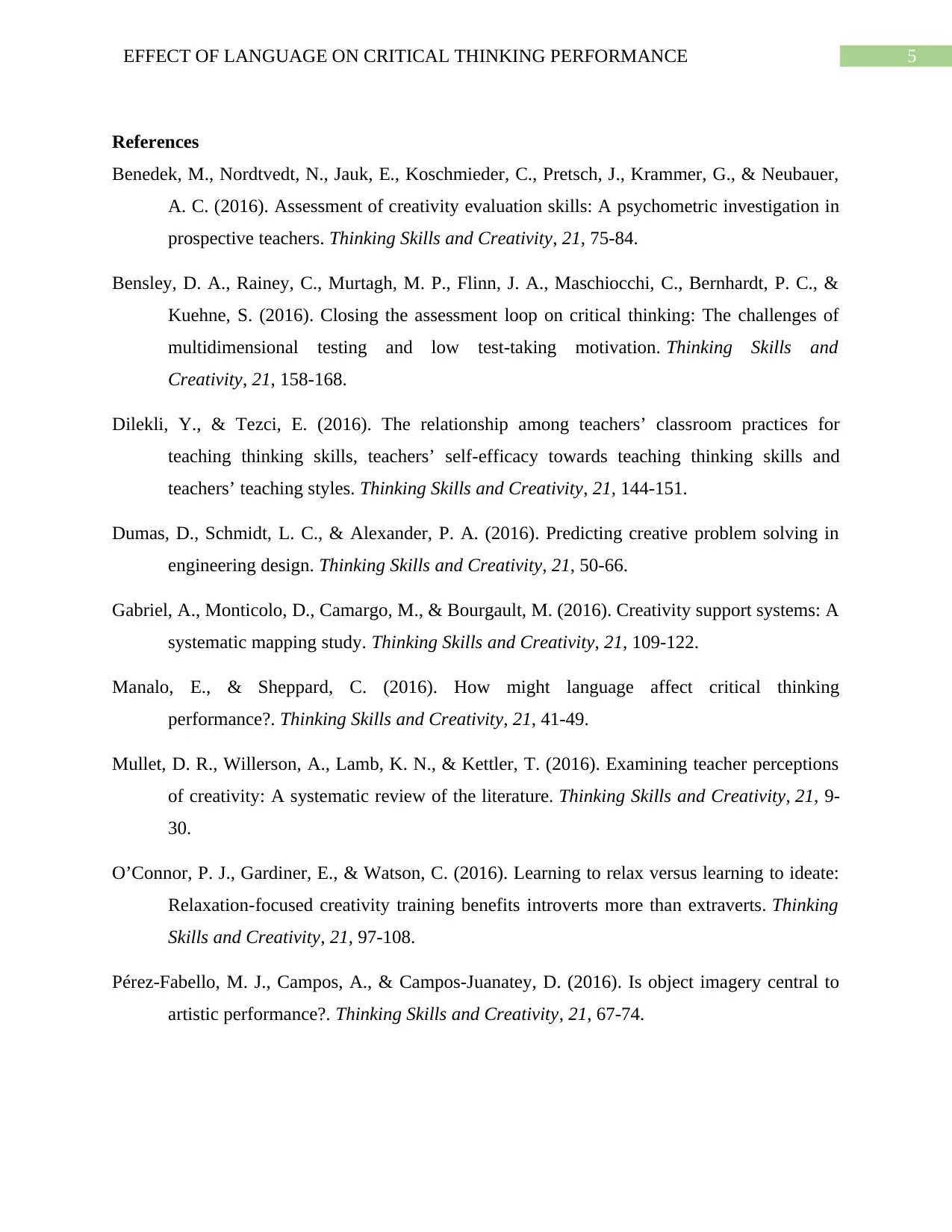
5EFFECT OF LANGUAGE ON CRITICAL THINKING PERFORMANCE
References
Benedek, M., Nordtvedt, N., Jauk, E., Koschmieder, C., Pretsch, J., Krammer, G., & Neubauer,
A. C. (2016). Assessment of creativity evaluation skills: A psychometric investigation in
prospective teachers. Thinking Skills and Creativity, 21, 75-84.
Bensley, D. A., Rainey, C., Murtagh, M. P., Flinn, J. A., Maschiocchi, C., Bernhardt, P. C., &
Kuehne, S. (2016). Closing the assessment loop on critical thinking: The challenges of
multidimensional testing and low test-taking motivation. Thinking Skills and
Creativity, 21, 158-168.
Dilekli, Y., & Tezci, E. (2016). The relationship among teachers’ classroom practices for
teaching thinking skills, teachers’ self-efficacy towards teaching thinking skills and
teachers’ teaching styles. Thinking Skills and Creativity, 21, 144-151.
Dumas, D., Schmidt, L. C., & Alexander, P. A. (2016). Predicting creative problem solving in
engineering design. Thinking Skills and Creativity, 21, 50-66.
Gabriel, A., Monticolo, D., Camargo, M., & Bourgault, M. (2016). Creativity support systems: A
systematic mapping study. Thinking Skills and Creativity, 21, 109-122.
Manalo, E., & Sheppard, C. (2016). How might language affect critical thinking
performance?. Thinking Skills and Creativity, 21, 41-49.
Mullet, D. R., Willerson, A., Lamb, K. N., & Kettler, T. (2016). Examining teacher perceptions
of creativity: A systematic review of the literature. Thinking Skills and Creativity, 21, 9-
30.
O’Connor, P. J., Gardiner, E., & Watson, C. (2016). Learning to relax versus learning to ideate:
Relaxation-focused creativity training benefits introverts more than extraverts. Thinking
Skills and Creativity, 21, 97-108.
Pérez-Fabello, M. J., Campos, A., & Campos-Juanatey, D. (2016). Is object imagery central to
artistic performance?. Thinking Skills and Creativity, 21, 67-74.
References
Benedek, M., Nordtvedt, N., Jauk, E., Koschmieder, C., Pretsch, J., Krammer, G., & Neubauer,
A. C. (2016). Assessment of creativity evaluation skills: A psychometric investigation in
prospective teachers. Thinking Skills and Creativity, 21, 75-84.
Bensley, D. A., Rainey, C., Murtagh, M. P., Flinn, J. A., Maschiocchi, C., Bernhardt, P. C., &
Kuehne, S. (2016). Closing the assessment loop on critical thinking: The challenges of
multidimensional testing and low test-taking motivation. Thinking Skills and
Creativity, 21, 158-168.
Dilekli, Y., & Tezci, E. (2016). The relationship among teachers’ classroom practices for
teaching thinking skills, teachers’ self-efficacy towards teaching thinking skills and
teachers’ teaching styles. Thinking Skills and Creativity, 21, 144-151.
Dumas, D., Schmidt, L. C., & Alexander, P. A. (2016). Predicting creative problem solving in
engineering design. Thinking Skills and Creativity, 21, 50-66.
Gabriel, A., Monticolo, D., Camargo, M., & Bourgault, M. (2016). Creativity support systems: A
systematic mapping study. Thinking Skills and Creativity, 21, 109-122.
Manalo, E., & Sheppard, C. (2016). How might language affect critical thinking
performance?. Thinking Skills and Creativity, 21, 41-49.
Mullet, D. R., Willerson, A., Lamb, K. N., & Kettler, T. (2016). Examining teacher perceptions
of creativity: A systematic review of the literature. Thinking Skills and Creativity, 21, 9-
30.
O’Connor, P. J., Gardiner, E., & Watson, C. (2016). Learning to relax versus learning to ideate:
Relaxation-focused creativity training benefits introverts more than extraverts. Thinking
Skills and Creativity, 21, 97-108.
Pérez-Fabello, M. J., Campos, A., & Campos-Juanatey, D. (2016). Is object imagery central to
artistic performance?. Thinking Skills and Creativity, 21, 67-74.
⊘ This is a preview!⊘
Do you want full access?
Subscribe today to unlock all pages.

Trusted by 1+ million students worldwide
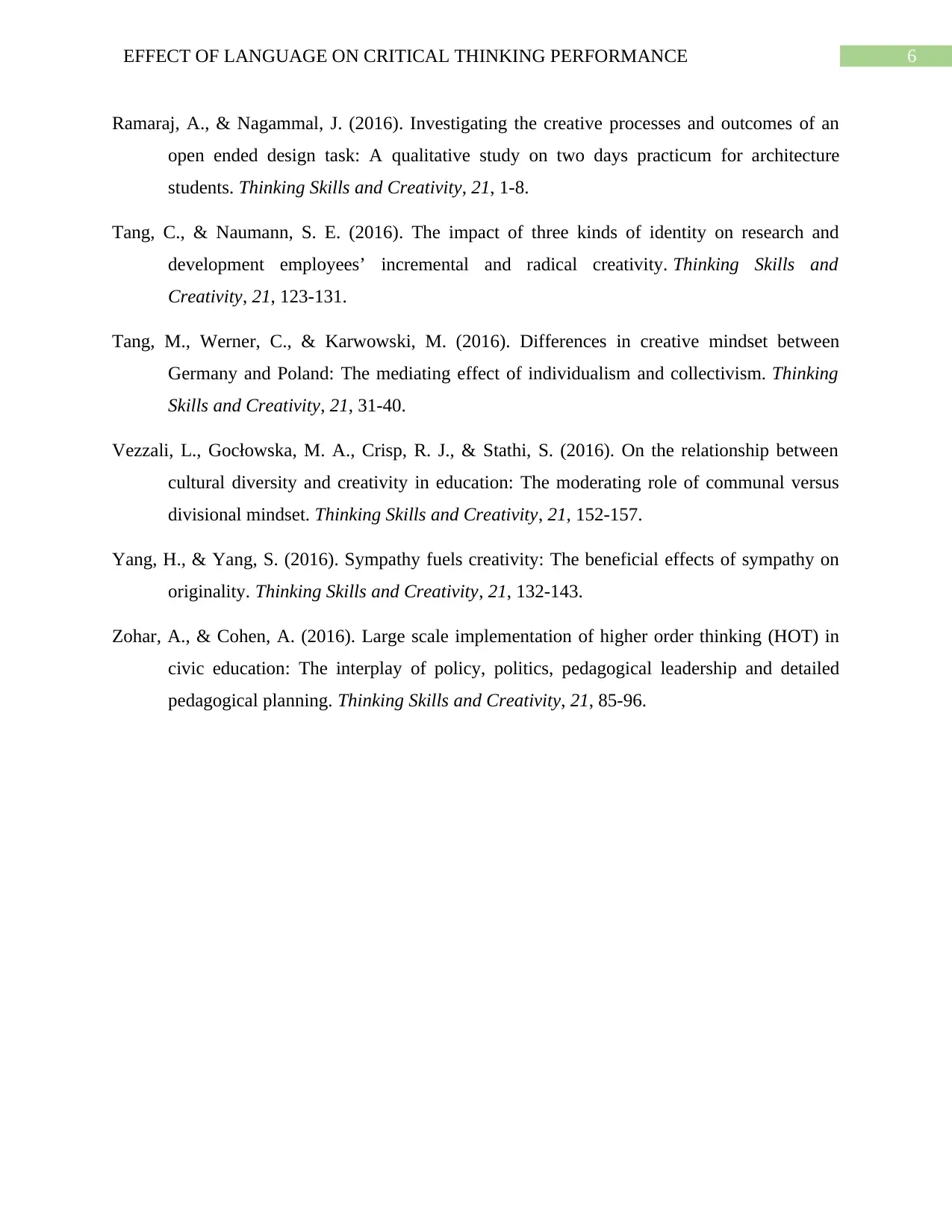
6EFFECT OF LANGUAGE ON CRITICAL THINKING PERFORMANCE
Ramaraj, A., & Nagammal, J. (2016). Investigating the creative processes and outcomes of an
open ended design task: A qualitative study on two days practicum for architecture
students. Thinking Skills and Creativity, 21, 1-8.
Tang, C., & Naumann, S. E. (2016). The impact of three kinds of identity on research and
development employees’ incremental and radical creativity. Thinking Skills and
Creativity, 21, 123-131.
Tang, M., Werner, C., & Karwowski, M. (2016). Differences in creative mindset between
Germany and Poland: The mediating effect of individualism and collectivism. Thinking
Skills and Creativity, 21, 31-40.
Vezzali, L., Gocłowska, M. A., Crisp, R. J., & Stathi, S. (2016). On the relationship between
cultural diversity and creativity in education: The moderating role of communal versus
divisional mindset. Thinking Skills and Creativity, 21, 152-157.
Yang, H., & Yang, S. (2016). Sympathy fuels creativity: The beneficial effects of sympathy on
originality. Thinking Skills and Creativity, 21, 132-143.
Zohar, A., & Cohen, A. (2016). Large scale implementation of higher order thinking (HOT) in
civic education: The interplay of policy, politics, pedagogical leadership and detailed
pedagogical planning. Thinking Skills and Creativity, 21, 85-96.
Ramaraj, A., & Nagammal, J. (2016). Investigating the creative processes and outcomes of an
open ended design task: A qualitative study on two days practicum for architecture
students. Thinking Skills and Creativity, 21, 1-8.
Tang, C., & Naumann, S. E. (2016). The impact of three kinds of identity on research and
development employees’ incremental and radical creativity. Thinking Skills and
Creativity, 21, 123-131.
Tang, M., Werner, C., & Karwowski, M. (2016). Differences in creative mindset between
Germany and Poland: The mediating effect of individualism and collectivism. Thinking
Skills and Creativity, 21, 31-40.
Vezzali, L., Gocłowska, M. A., Crisp, R. J., & Stathi, S. (2016). On the relationship between
cultural diversity and creativity in education: The moderating role of communal versus
divisional mindset. Thinking Skills and Creativity, 21, 152-157.
Yang, H., & Yang, S. (2016). Sympathy fuels creativity: The beneficial effects of sympathy on
originality. Thinking Skills and Creativity, 21, 132-143.
Zohar, A., & Cohen, A. (2016). Large scale implementation of higher order thinking (HOT) in
civic education: The interplay of policy, politics, pedagogical leadership and detailed
pedagogical planning. Thinking Skills and Creativity, 21, 85-96.
1 out of 7
Related Documents
Your All-in-One AI-Powered Toolkit for Academic Success.
+13062052269
info@desklib.com
Available 24*7 on WhatsApp / Email
![[object Object]](/_next/static/media/star-bottom.7253800d.svg)
Unlock your academic potential
Copyright © 2020–2025 A2Z Services. All Rights Reserved. Developed and managed by ZUCOL.



